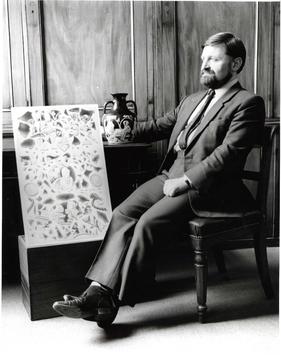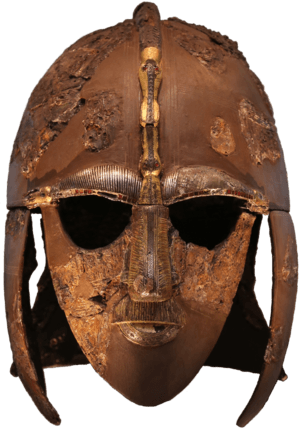Nigel Williams (conservator) facts for kids
Quick facts for kids
Nigel Williams
|
|
|---|---|

Nigel Williams with his restoration of the Portland Vase, copying a pose struck by the original restorer, John Doubleday; an 1845 watercolour by Thomas H. Shepherd shows the shattered fragments.
|
|
| Born |
Nigel Reuben Rook Williams
15 July 1944 Surrey, UK
|
| Died | 21 April 1992 (aged 47) Aqaba, Jordan
|
| Nationality | British |
| Occupation | Conservator |
| Years active | 1961–1992 |
| Known for | Reconstructing the Sutton Hoo helmet and the Portland Vase |
Nigel Reuben Rook Williams (born July 15, 1944 – died April 21, 1992) was a British expert who fixed and preserved old objects. He was especially good at restoring ceramics (like pottery) and glass. Nigel worked at the British Museum from 1961 until he passed away. He became the main expert for ceramics and glass in 1983. His most famous projects included putting back together the Sutton Hoo helmet and the amazing Portland Vase.
Nigel started at the British Museum when he was just 16 years old. He spent his whole career there. At that time, "conservation" (the job of preserving old items) wasn't a well-known profession. Nigel was one of the first people to study it. Even when he was young, he was trusted with very important objects. In the 1960s, he helped dig up the Sutton Hoo ship burial, a famous archaeological site. When he was in his early twenties, he worked on many of the items found there, especially the Sutton Hoo helmet. This project took him a whole year! He also put together other items from the burial, like a shield and drinking horns.
Nigel loved working with ceramics more than anything. In the 1970s and 1980s, he had many chances to do this. In 1974, almost 31,000 pieces of broken Greek vases were found from a sunken ship called HMS Colossus. Nigel worked to piece them back together. This process was even shown on TV, making him a well-known face. About ten years later, in 1988 and 1989, Nigel achieved his biggest success. He carefully took apart the Portland Vase, one of the most famous glass objects in the world, and put it back together perfectly. This restoration was also filmed by the BBC and, like the Sutton Hoo helmet, took almost a year to finish.
Nigel Williams died at age 47 from a heart attack. He was in Aqaba, Jordan, working on another British Museum dig. Today, a special award called the Nigel Williams Prize is given every two years by the Institute of Conservation. This award honors his important work in the field of conservation.
Contents
Nigel's Early Life
Nigel Williams was born in Surrey, England, on July 15, 1944. He had some health challenges when he was young, including rheumatic fever and dyslexia, which made school a bit harder. However, he still went on to study silversmithing and metal design at the Central School of Arts and Crafts. He was very good at it!
The school recommended him to the British Museum, and he started working there in 1961 as an assistant. At that time, being a conservator wasn't a recognized job. Nigel became only the second person at the museum to study conservation. He took a three-year part-time course at University College London's Institute of Archaeology.
Working at the British Museum
After joining the British Museum in 1961 and studying conservation, Nigel Williams worked on many different old objects. He fixed metals (like clocks), glass, stone, ivory, wood, and other natural materials. But his biggest passion was ceramics, which he loved the most.
Nigel was also very skilled at working with things found during archaeological digs. For example, he helped lift an old medieval tile kiln and a Roman mosaic from the ground. This mosaic is thought to be one of the earliest pictures of Christ. His most important work happened at the start and end of his career: putting together the Sutton Hoo helmet and the Portland Vase. In between these big projects, Nigel also pieced together nearly 31,000 fragments of Greek vases found from the sunken ship HMS Colossus (1787). In 1983, he was promoted to Chief Conservator of Ceramics and Glass, a position he held until he died.
The Sutton Hoo Helmet

Nigel's first major success came during the new digging of the Sutton Hoo ship burial site between 1965 and 1970. In 1966, he became the conservator for the Sutton Hoo finds. In the summer of 1967, he helped make molds of the ship's impression in the ground. The next summer, these molds were put back together in a warehouse to create a fibreglass copy. This process was more dangerous than people knew at the time, and it made Nigel allergic to a chemical called styrene for the rest of his life.
By 1968, as the Sutton Hoo dig was finishing, there were problems with how some of the finds had been put together. Nigel was put in charge of a team to continue their conservation. He worked on many objects, especially the helmet, shield, drinking horns, and wooden bottles. Nigel's co-workers at the museum called the Sutton Hoo helmet his "pièce de résistance" (masterpiece). This helmet is an iconic object from England's most famous archaeological discovery. It had been restored once before in 1945–1946.
Nigel carefully took apart the old restoration. From 1970 to 1971, he spent 18 months, including a full year of actual work, rearranging more than 500 fragments. No photos of the fragments were taken when they were first found in 1939, and their positions weren't recorded. Rupert Bruce-Mitford, who oversaw the work, said it was like "a jigsaw puzzle without any sort of picture on the lid of the box," and "a great many of the pieces missing." This was perfect for Nigel, who loved doing jigsaw puzzles to relax. The new helmet was shown on November 2, 1971, and everyone praised it.
The Colossus Vases
In the 1970s, Nigel Williams worked on putting together pieces of broken Greek vases. This was similar to the work he would later do on the Portland Vase. In 1798, the ship HMS Colossus sank, taking with it part of Sir William Hamilton's collection of vases. They lay broken for 200 years.
When the wreck was found in 1974, a rescue operation brought up about 30,935 fragments. When the British Museum got them, Nigel started putting them back together. He was helped by drawings of the vases made in the 1700s by Tischbein. This project was shown on television, and Nigel's natural talent made him a TV personality. He worked as if he were alone, and many people remember a moment in the TV show Chronicle when one of his partly finished restorations fell apart on camera! In 1978, Nigel and his team restored seven vases, either fully or partly, for an exhibition at the museum. For most of the other vases, there weren't enough pieces to make them complete, but 115 individual examples were identified.
The Portland Vase
The biggest achievement of Nigel Williams's career, according to his museum colleague Kenneth Painter, was his restoration of the Portland Vase in 1988–1989. The Journal of Glass Studies called the vase "probably the most famous glass object in the world." It is a masterpiece of Roman cameo glass, made around 30–20 B.C. The vase was first recorded in 1600–1601.
It was displayed at the British Museum in 1810. Then, in 1845, a young man intentionally broke it. It was fixed that same year by John Doubleday, and again in 1948–1949 by J. W. R. Axtell. By 1988, the glue used had turned yellow and become weak. Nigel Williams, along with his assistant Sandra Smith, was given the job of restoring the vase for a third time.
The BBC's History and Archaeology Unit filmed the process. Nigel began restoring the vase in June 1988. He took the vase apart by wrapping it inside and out with blotting paper and letting it sit in a glass container with special liquids for three days. This left it in 189 pieces. After removing the old glue and cleaning the fragments, Nigel used a strong glue called epoxy adhesive, Hxtal NYL, along with an acrylic resin to join the pieces.
Nigel and Sandra tried to avoid "trap-outs," which is when placing one piece stops the next one from fitting. They even worried over Christmas in 1988 that they might have to undo six months of work to fit the last few pieces. But their fears were wrong! After a few more weeks working on the top half of the vase, the final pieces fit perfectly. After nine months of work, only 17 tiny fragments were left out, compared to 34 in the previous restoration. After filling the cracks with colored resin, Nigel gave his simple verdict: "It's OK... ruined my Christmas."
Nigel's Personal Life
For 20 years, Nigel lived with his partner, Myrtle Bruce-Mitford. She was a professional cellist and the daughter of his colleague Rupert Bruce-Mitford. They met in 1964. Myrtle also helped with the Sutton Hoo finds, working for the British Museum on the remains of a lyre (an ancient musical instrument). She also helped update and publish the second edition of Nigel's book, Porcelain: Repair and Restoration, which he was working on when he died. Nigel and Myrtle had a daughter named Matty, who was born in 1976 or 1977.
Death and What He Left Behind
Nigel Williams died from a heart attack on April 21, 1992, at the age of 47. He had just arrived in Aqaba, Jordan, and was taking a break on the beach. He was working there as the conservator for a British Museum archaeological dig at Tell es-Sa'idiyeh. Even though he died young, Nigel, as Kenneth Painter wrote, "made a great contribution to the art and science of conservation." He helped preserve many important collections and helped the public understand the past better.
The Ceramics & Glass group of the Institute of Conservation gives out the Nigel Williams Prize every two years. This award remembers his work and encourages high standards for people working in conservation. The Institute notes that most conservators today don't often get to work on very famous objects like the Portland Vase. So, the prize is given to encourage good, consistent daily work, not just for big, dramatic projects. The judging panel for the award is led by Sandra Smith, who restored the Portland Vase with Nigel. Along with £1,000 for the winner, they also get a "virtual" image of a golden copy of the vase. The original copy was given by Wedgwood and is kept in their museum.

